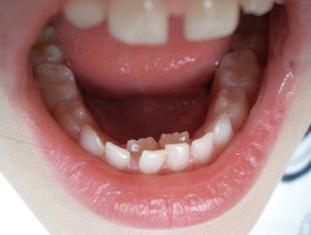
At around age 6 or 7, you can expect your child’s lower front baby tooth to get wiggly. As the adult incisor grows in (erupts), it produces chemicals that breaks down the root of the baby tooth it is replacing. This is why when the baby tooth is lost (exfoliates), there are no roots left and only the “crown” of the tooth remains.
Sometimes this root resorption is incomplete and the adult tooth starts appearing from behind the baby teeth. Not to worry! This is common and most of the time the adult incisor will push forward and the baby tooth will eventually come out on its own. On the rare occasion, we may have to help our child patient remove the baby tooth in the office if it appears to be taking too long to exfoliate and is actually impeding the growth of the adult tooth.

Around the same time, around age 6/7, the first adult molar appears in the mouth. This tooth does not replace a baby tooth, as it appears behind the second baby molar.
Overall, the eruption of adult teeth involves no pain at all. At times, the remaining wiggly baby teeth your child may complain that it is tender to bite on. When the baby tooth is loose, often it’s not being brushed and cleaned well which leads to gum inflammation which can lead to this discomfort.
This continual exfoliation of the baby teeth and eruption of adult teeth will continue until the early tweens with the eruption of the second molar. At your child’s, regular examination at North Delta Dental, we monitor the eruption of the teeth and monitor the space for all the teeth based on the size of the teeth and the relative skeletal growth. If there are any concerns, we may recommend a referral to an orthodontist for further assessment.
The last set of adult teeth to appear are the third molars or also known as the wisdom teeth. They will appear during the late teens to early 20s.